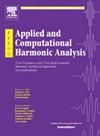具有近似保证的线性化瓦瑟斯坦降维法
IF 3.2
2区 数学
Q1 MATHEMATICS, APPLIED
引用次数: 0
摘要
我们介绍了 LOT Wassmap,这是一种在计算上可行的算法,用于揭示 Wasserstein 空间中的低维结构。该算法的动机是观察到许多数据集被自然地解释为概率度量,而不是 Rn 中的点,要找到这些数据集的低维描述,需要在 Wasserstein 空间中使用流形学习算法。大多数现有算法都基于计算成对的 Wasserstein 距离矩阵,这对于高维度的大型数据集来说,计算难度很大。我们的算法利用 Sinkhorn 距离和线性化最优传输等近似方案来加快计算速度,尤其是避免了计算成对距离矩阵。我们为这种近似方法下的嵌入质量提供了保证,包括在没有明确的概率度量描述而必须处理有限样本的情况下。实验证明,LOT Wassmap 可以获得正确的嵌入,而且质量会随着样本量的增加而提高。我们还展示了与依赖成对距离计算的算法相比,LOT Wassmap 如何显著降低计算成本。本文章由计算机程序翻译,如有差异,请以英文原文为准。
Linearized Wasserstein dimensionality reduction with approximation guarantees
We introduce LOT Wassmap, a computationally feasible algorithm to uncover low-dimensional structures in the Wasserstein space. The algorithm is motivated by the observation that many datasets are naturally interpreted as probability measures rather than points in , and that finding low-dimensional descriptions of such datasets requires manifold learning algorithms in the Wasserstein space. Most available algorithms are based on computing the pairwise Wasserstein distance matrix, which can be computationally challenging for large datasets in high dimensions. Our algorithm leverages approximation schemes such as Sinkhorn distances and linearized optimal transport to speed-up computations, and in particular, avoids computing a pairwise distance matrix. We provide guarantees on the embedding quality under such approximations, including when explicit descriptions of the probability measures are not available and one must deal with finite samples instead. Experiments demonstrate that LOT Wassmap attains correct embeddings and that the quality improves with increased sample size. We also show how LOT Wassmap significantly reduces the computational cost when compared to algorithms that depend on pairwise distance computations.
求助全文
通过发布文献求助,成功后即可免费获取论文全文。
去求助
来源期刊

Applied and Computational Harmonic Analysis
物理-物理:数学物理
CiteScore
5.40
自引率
4.00%
发文量
67
审稿时长
22.9 weeks
期刊介绍:
Applied and Computational Harmonic Analysis (ACHA) is an interdisciplinary journal that publishes high-quality papers in all areas of mathematical sciences related to the applied and computational aspects of harmonic analysis, with special emphasis on innovative theoretical development, methods, and algorithms, for information processing, manipulation, understanding, and so forth. The objectives of the journal are to chronicle the important publications in the rapidly growing field of data representation and analysis, to stimulate research in relevant interdisciplinary areas, and to provide a common link among mathematical, physical, and life scientists, as well as engineers.
 求助内容:
求助内容: 应助结果提醒方式:
应助结果提醒方式:


